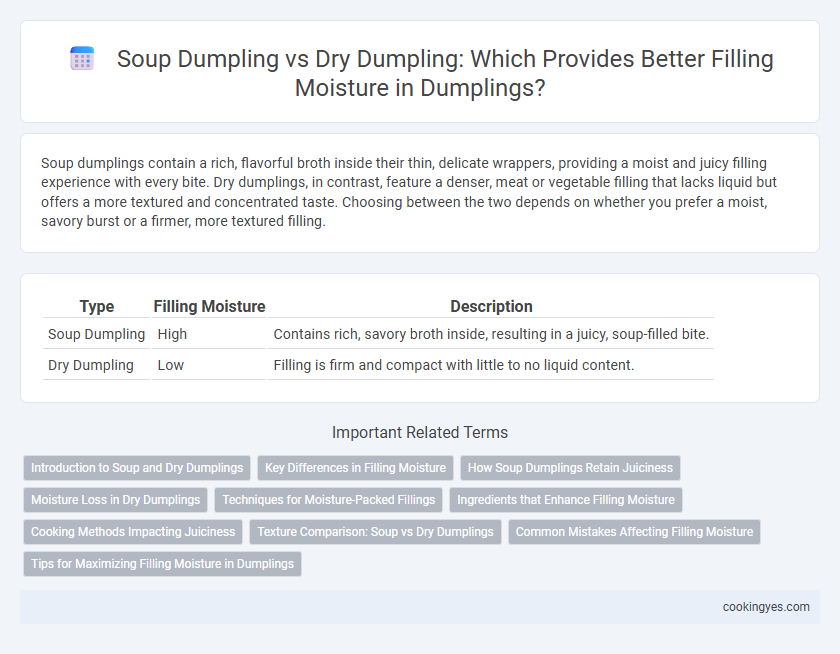Soup dumplings contain a rich, flavorful broth inside their thin, delicate wrappers, providing a moist and juicy filling experience with every bite. Dry dumplings, in contrast, feature a denser, meat or vegetable filling that lacks liquid but offers a more textured and concentrated taste. Choosing between the two depends on whether you prefer a moist, savory burst or a firmer, more textured filling.
Table of Comparison
| Type | Filling Moisture | Description |
|---|---|---|
| Soup Dumpling | High | Contains rich, savory broth inside, resulting in a juicy, soup-filled bite. |
| Dry Dumpling | Low | Filling is firm and compact with little to no liquid content. |
Introduction to Soup and Dry Dumplings
Soup dumplings, often known as xiaolongbao, are prized for their delicate, thin dough encasing a juicy filling combined with savory broth, delivering a burst of flavorful soup upon biting. Dry dumplings lack the liquid broth component, featuring a firmer, more concentrated filling with reduced moisture, offering a chewier texture and robust taste. The contrast between soup and dry dumplings lies primarily in filling moisture content, influencing their overall mouthfeel and eating experience.
Key Differences in Filling Moisture
Soup dumplings contain a rich, gelatinized broth that liquefies when steamed, providing a juicy, flavorful burst with every bite, whereas dry dumplings have a firmer, less moist filling composed primarily of ground meat or vegetables. The key difference in filling moisture lies in the presence of aspic in soup dumplings, which melts to create a soupy interior, contrasting with the denser, drier texture of traditional dry dumplings. This moisture variation significantly impacts the eating experience, with soup dumplings offering a delicate, savory juice that dry dumplings lack.
How Soup Dumplings Retain Juiciness
Soup dumplings retain juiciness by encasing a rich broth within a delicate dough skin, created through gelatinized meat aspic that melts during steaming to release flavorful liquid. The thin, elastic wrapper seals in moisture, preventing evaporation and preserving the dumpling's signature succulent texture. This unique steaming method contrasts with dry dumplings, which lack broth and rely solely on filling moisture content, resulting in a denser, less juicy bite.
Moisture Loss in Dry Dumplings
Soup dumplings contain a gelatin-rich broth that liquefies when steamed, preserving high moisture content and delivering a juicy bite. Dry dumplings lack this soup component, resulting in significant moisture loss during cooking as the filling dries out and tightens. This moisture loss in dry dumplings affects texture, often leading to a denser and less succulent filling compared to their soup-filled counterparts.
Techniques for Moisture-Packed Fillings
Soup dumplings utilize gelatin-rich broth that melts into liquid during steaming, creating a soupy, moist filling, while dry dumplings rely on finely minced, well-marinated ingredients to retain natural juiciness without added liquid. Techniques for moisture-packed fillings include using high-quality, fatty pork mixed with gelatinized stock or aspic for soup dumplings, and incorporating water-binding ingredients like finely chopped vegetables or moisture-retentive fats for dry dumplings. Precise temperature control during steaming or frying is crucial to maintain the desired filling texture without drying out the dumplings.
Ingredients that Enhance Filling Moisture
Soup dumplings achieve their signature juicy filling through gelatin-rich pork broth or chicken stock that liquefies when steamed, creating a burst of flavorful soup inside. Dry dumplings rely on high-fat meats like pork belly or fatty beef combined with water-retaining ingredients such as finely chopped vegetables or mushrooms to maintain moisture without liquid broth. Incorporating ingredients like soy sauce, ginger, and scallions enhances the filling's overall juiciness and taste by naturally locking in moisture.
Cooking Methods Impacting Juiciness
Soup dumplings contain a gelatinized broth inside that melts during steaming, creating a juicy, soupy filling, while dry dumplings lack this broth and rely solely on the meat or vegetable fillings for moisture. Steaming preserves the soup dumpling's delicate texture and liquid center, enhancing juiciness, whereas pan-frying or boiling dry dumplings intensifies the filling's density but reduces moisture retention. The cooking method significantly affects moisture distribution, with steam cooking best suited for maximizing soup dumpling juiciness compared to the firmer, drier texture of dry dumplings prepared by other methods.
Texture Comparison: Soup vs Dry Dumplings
Soup dumplings feature a delicate, thin skin that encases a savory broth along with the filling, resulting in a moist and juicy bite that bursts with flavorful soup upon chewing. Dry dumplings have a firmer, thicker wrapper that absorbs less moisture, producing a denser texture with concentrated filling flavors and a chewy bite. The contrasting textures highlight the soup dumpling's silkiness and succulence against the dry dumpling's hearty, satisfying chew.
Common Mistakes Affecting Filling Moisture
Soup dumplings often suffer from overfilling or insufficient sealing, causing broth leakage and loss of juiciness, while dry dumplings commonly face under-seasoning or overcooking, leading to dry, tough filling. Using the correct dough thickness and ensuring proper steaming time are critical to maintaining optimal moisture balance in both types. Avoiding these common mistakes preserves the delicate texture and rich flavors integral to authentic dumpling experiences.
Tips for Maximizing Filling Moisture in Dumplings
Soup dumplings feature a gelatinized broth that melts during steaming, delivering a juicy, flavorful filling, while dry dumplings rely on finely minced, high-fat meat to retain moisture. To maximize filling moisture, incorporate rich broth aspic or pork fat into the mix and avoid overcooking, which causes moisture loss. Using a combination of moisture-retentive ingredients such as minced fatty pork and broth gel improves succulence in both soup and dry dumplings.
Soup dumpling vs Dry dumpling for filling moisture Infographic

 cookingyes.com
cookingyes.com